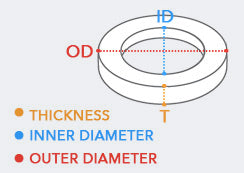Recommend
Very good quality, reasonable prices.
Product code: 23008


 Earn 7 points for this product with AMF Magnetics Perks
Earn 7 points for this product with AMF Magnetics Perks
Prices are GST Incl.
Request a Quote for Bulk OrdersAustralia's Leading Supplier
Shipping Worldwide*
30 Day Returns
Same Day Dispatch*

This rare earth ring magnet has an outside diameter of 19mm, an inside diameter of 8mm and a thickness of 4mm. It is identified by the AMF magnet part number 23008.
Engineering and chemical engineering tertiary degrees proliferate in the light and heavy rail industry. So do magnets of all kinds in many different applications, including these neodymium ring magnets. Found throughout the rolling stock within wheel assemblies, braking systems and traction components, magnets are also used extensively in the lifting and depot equipment in the rail workshops.
Ring magnets engaged on an axle or rod with stationary and moving parts are used to help regulate movement necessary to ensure smooth operation of rail travel. Livestock and cargo benefit from a gentle ride as well as people.
Smooth operation of rolling stock also reduces wear and tear on the wheels and brakes and rail tracks as well as reduces noise. The known pull force of magnets allows engineers to determine release points within the system to control the transfer of force, or reduce the amount of force being directly transferred through the various assemblies.
Magnets, some very large and very small have played a vital role since the beginning of rail travel. For the coupling of the carriages, magnetic engagement has been very useful in mitigating the wild forces that swaying carriages moving at speed are able to generate. Magnetic engagement between the individual carriages also allow the engineers or builders of trains to determine at which point a carriage, often for the good of the entire train should release.
This method, or fail safe system acts a circuit breaker with the trains’ assembly, allowing one or two carriages to suffer the consequences of unexpected force while mitigating damage to the locomotive and other carriages. Magnetic engagement allows for the subtraction and addition of other carriages simply and quickly. Magnets have always, are still are, helping our trains run smoother, safer and faster for longer.
No FAQ available

This rare earth ring magnet has an outside diameter of 19mm, an inside diameter of 8mm and a thickness of 4mm. It is identified by the AMF magnet part number 23008.
Engineering and chemical engineering tertiary degrees proliferate in the light and heavy rail industry. So do magnets of all kinds in many different applications, including these neodymium ring magnets. Found throughout the rolling stock within wheel assemblies, braking systems and traction components, magnets are also used extensively in the lifting and depot equipment in the rail workshops.
Ring magnets engaged on an axle or rod with stationary and moving parts are used to help regulate movement necessary to ensure smooth operation of rail travel. Livestock and cargo benefit from a gentle ride as well as people.
Smooth operation of rolling stock also reduces wear and tear on the wheels and brakes and rail tracks as well as reduces noise. The known pull force of magnets allows engineers to determine release points within the system to control the transfer of force, or reduce the amount of force being directly transferred through the various assemblies.
Magnets, some very large and very small have played a vital role since the beginning of rail travel. For the coupling of the carriages, magnetic engagement has been very useful in mitigating the wild forces that swaying carriages moving at speed are able to generate. Magnetic engagement between the individual carriages also allow the engineers or builders of trains to determine at which point a carriage, often for the good of the entire train should release.
This method, or fail safe system acts a circuit breaker with the trains’ assembly, allowing one or two carriages to suffer the consequences of unexpected force while mitigating damage to the locomotive and other carriages. Magnetic engagement allows for the subtraction and addition of other carriages simply and quickly. Magnets have always, are still are, helping our trains run smoother, safer and faster for longer.
No FAQ available

The Pull Force listed for each magnet is based on lifting 10mm thick steel from a horizontal surface. Magnets on a vertical surface (of 10mm thick steel) are generally able to hold around only 30% of the pull force listed in the product description. This is due to the effects of gravity and the lack of friction between the surface and the shiny magnet. Read More